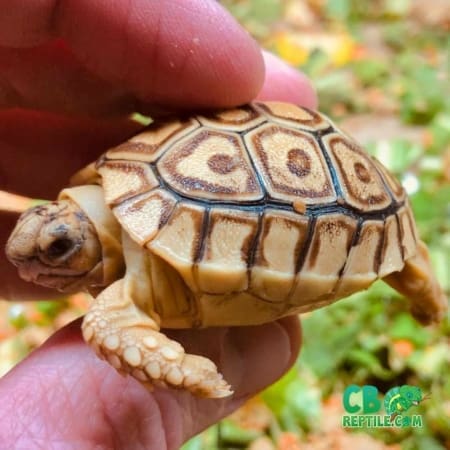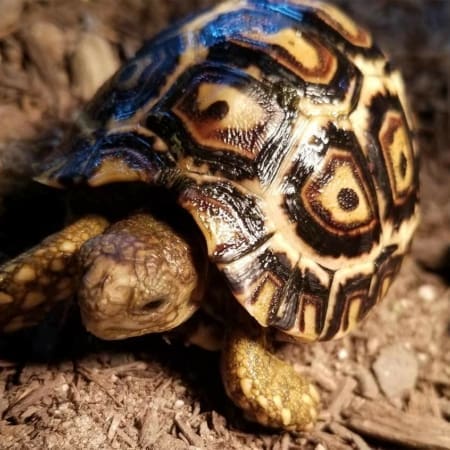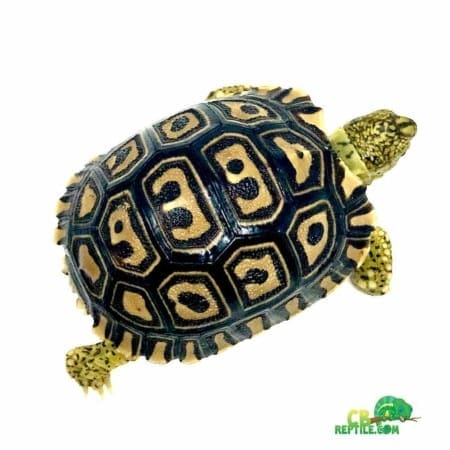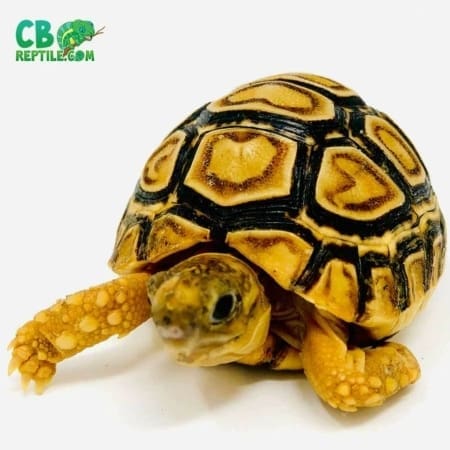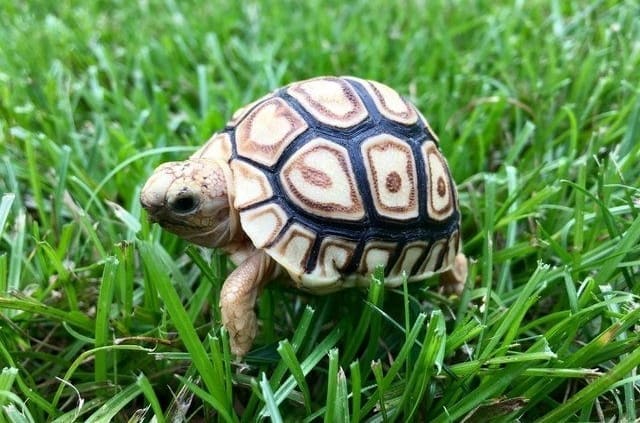
Leopard Tortoises for Sale
Interested in buying leopard tortoises for sale? Look no further because CbReptile.com has one of the largest varieties of leopard tortoises for sale online.
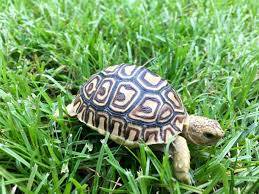
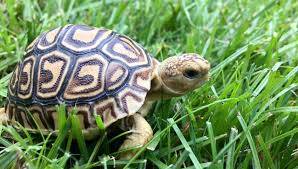 We have some amazing leopard tortoises for sale! We many leopard tortoises for sale including baby leopard tortoise for sale, well started 6-month-old baby leopard tortoises for sale, yearling leopard tortoises for sale and adult leopard tortoise for sale online.
We have some amazing leopard tortoises for sale! We many leopard tortoises for sale including baby leopard tortoise for sale, well started 6-month-old baby leopard tortoises for sale, yearling leopard tortoises for sale and adult leopard tortoise for sale online.
We offer both the traditional pardalis babcocki leopard tortoise from northern and eastern african regions as well the more rare and highly sought after giant south african leopard tortoise for sale, known as Pardalis Pardalis for sale. The Giant South African leopard tortoises for sale are a bit larger, with a milder domed shell and darker, higher pigmented markings.
General Housing:
Being such a large species means that Leopards require quite extensive accommodation. Add to this the fact that they are a species which does NOT hibernate then the keeper is left with the problem of providing all year round outdoor accommodation and the added expense of maintaining high temperatures during the winter months.
This is quite easily overcome whilst the tortoises are juveniles; the tortoises can be brought indoors and housed on a tortoise table until the following spring/summer when they can be put back outside. However once they start to grow bringing them indoors for the winter become less of an option for most people.
It is at this stage that the keeper finds out just how expensive it can be to insulate and heat a shed or greenhouse throughout the winter in the UK. Unfortunately it also at this stage when the keeper decides that they can no longer provide appropriate care and the tortoise needs to be rehomed.
Heating and Lighting:
Adequate heating and lighting can be achieved in a number of ways but first and foremost natural unfiltered sunlight is far better than any UVB bulb. Even on a cloudy day here in the UK solar radiation is far stronger than the best UVB bulb.
It isn’t nearly as good as the levels of UVB light leopards would receive in their natural environment in Africa, but it is still better than denying it to them. Leopards should be exposed to as much sunlight as possible. Indoors the kind of heating element used will depend on personal preference and the area to be heated.
Some people prefer to provide UVB lighting using the full spectrum tube type bulbs, and provide heat by means of a basking bulb linked to a thermostat. Others choose to use a combined Heat/UVB bulb. These are suitable for tortoise tables as they provide both the UVB and the heat from one source.
They can not be used with a thermostat so the temperature of the hot spot under the bulb is controlled by either raising or lowering the height of the bulb until the desired temperature is achieved. The heating of large outdoor setups can not be achieved with UVB/Heat bulbs alone. Background heating, by using heat lamps, ceramic heater emitters, and tubular greenhouse heaters, have all been used with varying degrees of success.
The UVB and a basking hotspot can then be provided using the combined bulb or UVB tube. Heating needs to be maintained throughout the year and electricity costs can be high. In all cases the 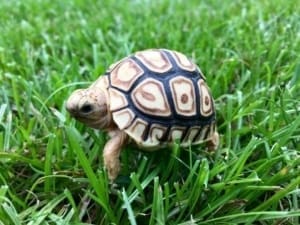 provision of a temperature gradient for the tortoise is paramount.
provision of a temperature gradient for the tortoise is paramount.
Temperature under the basking lamp during the day should be approximately 30°C (86°F) to 32 (90°F) with a cooler background area of 20°C (68°F) to 21°C (70°F ) . A drop in temperature during the night is required, but the temperature must be set to no lower than 16°C (60°F). Leopards do not like and cannot tolerate cold and damp conditions and if cared for in this type of environment their resistance to infection and disease will be increased, so it is essential that this part of their care is correct.
Feeding and Dietary Supplementation:
Leopard tortoises are strictly herbivores and in the wild are natural grazers, the bulk of their diet being made up of various grasses and hays. In captivity the provision of a diet as close to this as possible is what the keeper should aim for. It is important not to overfeed as even too much of the correct diet can cause growth problems.
A good balanced diet containing the correct balance of protein, carbohydrates, fats, fibre, vitamins and minerals is essential and if provided, and free of chemicals, will assist in the development of a healthy immunological system.
The Leopard tortoises diet should be very high in fibre and made up of about 70% grasses and hay, the remaining 30% should be made up of essential weeds and flowers. Other plant material such as opuntia cactus pads and its fruit is also very high in fibre and can be fed in small quantities. The following list of food items is intended to assist the Leopard keeper in providing a varied and balanced diet, but is by no means exhaustive. The list also draws attention to some food items that should be avoided and in some cases are particularly dangerous to the tortoise.
Grass: A variety of grasses is best and the Leopard should be allowed to graze freely in warm conditions. Meadow hay, timothy hay and orchard hay are suitable alternatives when grasses aren’t readily available. Readi-grass or Graze-On are other alternatives which can be purchased from horse feed suppliers and some pet care outlets.
Essential Weeds: Plantain, both broad and narrow leaf, dandelion leaves and flowers, chickweed, clover. Suitable weeds and plants: Thistle, hibiscus leaves and flowers, mulberry leaves, tradescantia, opuntia pads and fruit, echeveria, abutilon, kalanchoe, mimula, petunias, viola, flatleaf watercress (Rorippa nasturtium-aquaticum) but not salad cress, American Land Cress (Barbarea verna), sowthistle, endive, agave, lavatera flowers and leaves.
Foods to be avoided: Fruit: Leopard tortoises do not eat any fruit in the wild and if given it can cause gastro-intestinal disturbances from increased lactic acid levels and a potential increase in parasitic infestation, potentially resulting in a sterile gut which could be fatal. Calcium should also always be provided with cuttlebone.
Tortoise for sale online from CB Reptile
At CBReptile.com, we specialize in all types of tortoise for sale, baby turtles for sale, adult tortoises for sale online as well as baby tortoises for sale. We breed here on site and work with captive bred tortoises for sale online. If you are looking for a tortoise for sale online, you have come to the right tortoise breeder.
Our tortoise farm is the best of any of the tortoise farms in the country as we work with over 25 species of captive bred reptiles for sale including turtles for sale online as well. Our sister site, tortoise town also offers tortoise for sale and tortoises for sale online, including sulcata tortoise for sale, leopard tortoise for sale, russian tortoise for sale and other captive-bred species of box turtles for sale and turtles for sale online.
Baby tortoises for sale
Some other species of pet tortoise for sale include the Sulcata tortoise, the Russian tortoise, Egyptian tortoise, Hermann’s tortoise. Other species of large tortoise for sale or giant tortoise for sale include Aldabra tortoise, Sulcata tortoises, Leopard tortoise, giant leopard tortoise.
Some medium-sized tortoises for sale include red foot tortoise, yellow foot tortoise, cherry head tortoise, Burmese star tortoise, and Sri Lankan Star tortoise. Other small tortoise includes the Indian star tortoise, western Hermann’s tortoise, and greek tortoise to name a few.
Reptiles for sale online
We are not only leopard gecko breeders! We are also proud to be crested gecko breeders as well as gargoyle gecko breeders! Be sure to checkout all of our leopard gecko for sale, as well as our baby leopard geckos for sale, crested gecko for sale, gargoyle gecko for sale as well as our panther chameleons for sale and iguanas for sale. We also offer ball python for sale, baby ball pythons for sale, bearded dragon for sale, tegu for sale, blue tongue skink for sale and more!
- Display 15 Products per page

